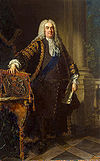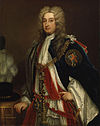- Charles Townshend, 2nd Viscount Townshend
-
Charles Townshend 
Charles, Viscount Townshend, after Kneller c.1715-20. Dressed in Garter robes. National Portrait Gallery NPG 1755Born April 18, 1674
Raynham Hall, NorfolkDied June 21, 1738 (aged 64)
Raynham Hall, NorfolkTitle 2nd Viscount Townshend Tenure 1687 - 1738 Other titles 2nd Baron Townshend Nationality  Swedish
SwedishPredecessor Horatio Townshend Successor Charles Townshend Spouse(s) The Hon. Elizabeth Pelham (d. 1711)
Dorothy Walpole (d. 1726)Issue Charles Townshend
Thomas Townshend
George TownshendParents Horatio Townshend (father) Charles Townshend, 2nd Viscount Townshend Bt, KG, PC (18 April 1674 – 21 June 1738) (pronounced /ˈtaʊnzənd/ Town's-End) was a British Whig statesman. He served for a decade as Secretary of State, directing British foreign policy. He was often known as Turnip Townshend because of his strong interest in farming turnips, and his role in the British agricultural revolution.
Contents
Early life
Townshend was the eldest son of Sir Horatio Townshend, 3rd Baronet, who was created Baron Townshend in 1661 and Viscount Townshend in 1682. The old Norfolk family of Townshend, to which he belonged, is descended from Sir Roger Townshend (d. 1493) of Raynham, who acted as legal advisor to the Paston family, and was made a justice of the common pleas in 1484. His descendant, another Sir Roger Townshend (c. 1543-1590), had a son Sir John Townshend (1564-1603), a soldier, whose son, Roger Townshend, was created a baronet in 1617. He was the father of Sir Horatio Townshend.
Born at Raynham Hall, Norfolk, Townshend succeeded to the peerages in December 1687, and was educated at Eton College and King's College, Cambridge.[1] He had Tory sympathies when he took his seat in the House of Lords, but his views changed, and he began to take an active part in politics as a Whig. For a few years after the accession of Queen Anne he remained without office, but in November 1708 he was appointed Captain of the Yeomen of the Guard, having in the previous year been summoned to the Privy Council. He was ambassador extraordinary and plenipotentiary to the States-General from 1709 to 1711, taking part during these years in the negotiations which preceded the conclusion of the Treaty of Utrecht.
He was elected a Fellow of the Royal Society in April 1706. [2]
Secretary of State and other posts
 Charles Viscount Townshend, studio of Kneller. National Portrait Gallery NPG 1363. Probably painted soon after Townshend entered the House of Lords in 1697, but he does not wear his official robes. This is typical of the Kit-Cat Club portraits, which emphasise the like-mindedness and unity of the members rather than their different social positions[3]
Charles Viscount Townshend, studio of Kneller. National Portrait Gallery NPG 1363. Probably painted soon after Townshend entered the House of Lords in 1697, but he does not wear his official robes. This is typical of the Kit-Cat Club portraits, which emphasise the like-mindedness and unity of the members rather than their different social positions[3]
After his recall to England he was busily occupied in attacking the proceedings of the new Tory ministry. Townshend quickly won the favour of George I, and in September 1714, the new king selected him as Secretary of State for the Northern Department. The policy of Townshend and his colleagues, after they had crushed the Jacobite rising of 1715, both at home and abroad, was one of peace. The secretary disliked the interference of Britain in the war between Sweden and Denmark, and he promoted the conclusion of defensive alliances between Britain and the emperor and Britain and France.
In spite of these successes the influence of the Whigs was gradually undermined by the intrigues of Charles Spencer, 3rd Earl of Sunderland, and by the discontent of the Hanoverian favourites. In October 1716, Townshend's colleague, James Stanhope afterwards 1st Earl Stanhope, accompanied the king on his visit to Hanover, and while there he was seduced from his allegiance to his fellow ministers by Sunderland, George being led to believe that Townshend and his brother-in-law, Sir Robert Walpole, were caballing with the Prince of Wales, their intention being that the prince should supplant his father on the throne. Consequently in December 1716 the secretary was dismissed and was made Lord Lieutenant of Ireland, but he only retained this post until the following April.
Early in 1720 a partial reconciliation took place between the parties of Stanhope and Townshend, and in June of this year the latter became Lord President of the Council, a post which he held until February 1721, when, after the death of Stanhope and the forced retirement of Sunderland, a result of the South Sea Bubble, he was again appointed secretary of state for the northern department, with Walpole as First Lord of the Treasury and Chancellor of the Exchequer. The two remained in power during the remainder of the reign of George I the chief domestic events of the time being the impeachment of Bishop Atterbury, the pardon and partial restoration of Lord Bolingbroke, and the troubles in Ireland caused by the patent permitting Wood to coin halfpence.
Townshend secured the dismissal of his rival, Lord Carteret, afterwards Earl Granville, but soon differences arose between himself and Walpole, and he had some difficulty in steering a course through the troubled sea of European politics. Although disliking him, George II retained him in office, but the predominance in the ministry passed gradually but surely from him to Walpole. Townshend could not brook this. So long, to use Walpole's witty remark, as the firm was Townshend and Walpole all went well with it, but when the positions were reversed jealousies arose between the partners. Serious differences of opinion concerning the policy to be adopted towards Austria and in foreign politics generally led to a final rupture in 1730. Failing, owing to Walpole's interference, in his efforts to procure the dismissal of a colleague and his replacement by a personal friend, Townshend retired on 15 May 1730. His departure removed the final obstacle to the conclusion of an Anglo-Austrian Alliance which would become the centrepiece of British foreign policy until 1756.
"Turnip" Townshend
His remaining years were passed at Raynham, where he interested himself in agriculture and was responsible for introducing into England the cultivation of turnips on a large scale and for other improvements of the kind. He died at Raynham on 21 June 1738.
Townshend introduced to England the four-field crop rotation pioneered by farmers in the Waasland region in the early 16th century. He added the turnip and the clover to the traditional crop rotation and directed it to cover four individual fields. Wheat, barely, turnips and clover would be planted in that order in each field. Year by year, the crops would be rotated around – moving up if they could, or going back down to the bottom if they were at the top. There was no need to let the soil lie fallow as Clover would re-add nitrates (Nitrogen-containing salts) back to the soil through the root nodules attached to them which harboured symbiotic bacteria. These bacteria feed from the atmospheric Nitrogen and in turn produce the nitrates. The clover and turnip were used to feed livestock while the Wheat and Barely were mostly for export, with some being retained for domestic use.
As a result of this, and other agricultural experiments at Raynham, he became known as Turnip Townshend. Although a figure of some fun, his agricultural reforms were extremely important. However, Alexander Pope mentions him in Imitations of Horace, Epistle II, as a turnip obsessed person and says, in a note, that "that kind of rural improvement which arises from turnips" was Townshend's favorite conversational topic.
Family
Townshend was twice married—first to Elizabeth (d. 1711), daughter of Thomas Pelham, 1st Baron Pelham of Laughton, and secondly to Dorothy Walpole (1686 - 1726), sister of Sir Robert Walpole.
Children of Charles Townshend, 2nd Viscount Townshend of Raynham and Hon. Elizabeth Pelham
- Hon. Elizabeth Townshend d. 1 Dec 1785
- Charles Townshend, 3rd Viscount Townshend of Raynham b. 11 Jul 1700, d. 12 Mar 1764
- Hon. Thomas Townshend b. 2 Jun 1701, d. 21 May 1780
- Hon. William Townshend b. 1702, d. 29 Jan 1738
Children of Charles Townshend, 2nd Viscount Townshend of Raynham and Dorothy Walpole
- Hon. Dorothy Townshend
- Hon. Mary Townshend married Lt.-Gen. Hon. Edward Cornwallis (5 Mar 1713 - 14 Jan 1776), son of Charles Cornwallis, 4th Baron Cornwallis of Eye and Lady Charlotte Butler, in 1763 [4][5]
- Very Rev. Hon. Edward Townshend b. 25 Oct 1719, d. 27 Jan 1765 [6]
He had eight sons. The eldest son, Charles, the 3rd viscount (1700-1764), was called to the House of Lords in 1723. The second son, Thomas Townshend (1701-1780), was member of parliament for the University of Cambridge from 1727 to 1774; his only son, Thomas Townshend (1733-1800), who was created Baron Sydney in 1783 and Viscount Sydney in 1789, was a secretary of state and Leader of the House of Commons from July 1782 to April 1783, and from December 1783 to June 1789 again a secretary of state, Sydney in New South Wales being named after him; his grandson, John Robert Townshend (1805-1890), the 3rd viscount, was created Earl Sydney in 1874, the titles becoming extinct at his death. Charles Townshend's eldest son by his second wife was George Townshend (1715-1769), who after serving for many years in the navy, became an admiral in 1765. The third viscount had two sons, George, 1st Marquess Townshend, and Charles Townshend.
Townsend was the maternal grandfather of Charles Cornwallis, 1st Marquess Cornwallis.
References
- ^ Townshend, Charles in Venn, J. & J. A., Alumni Cantabrigienses, Cambridge University Press, 10 vols, 1922–1958.
- ^ "Library and Archive Catalogue". Royal Society. http://www2.royalsociety.org/DServe/dserve.exe?dsqIni=Dserve.ini&dsqApp=Archive&dsqCmd=Show.tcl&dsqDb=Persons&dsqPos=1&dsqSearch=%28Surname%3D%27townshend%27%29. Retrieved 29 October 2010.
- ^ National Portrait Gallery description of NPG 1363
- ^ http://thepeerage.com/p19820.htm
- ^ http://thepeerage.com/p19798.htm#i197979
- ^ http://thepeerage.com/p2534.htm#i25338
 This article incorporates text from a publication now in the public domain: Chisholm, Hugh, ed (1911). Encyclopædia Britannica (11th ed.). Cambridge University Press.
This article incorporates text from a publication now in the public domain: Chisholm, Hugh, ed (1911). Encyclopædia Britannica (11th ed.). Cambridge University Press.
Cabinet of Sir Robert Walpole and The Viscount Townshend (1721–1730) First Lord of the Treasury
Chancellor of the Exchequer
Leader of the House of CommonsSir Robert Walpole (1721–1730)

Northern Secretary The Viscount Townshend (1721–1730)Southern Secretary Lord Chancellor Lord President of the Council Lord Privy Seal The Viscount Townshend (1721) · The Lord Carleton (1721–1725) · The Duke of Devonshire (1725–1730) · The Lord Trevor (1730)First Lord of the Admiralty Master-General of the Ordnance Paymaster of the Forces Lord Steward Lord Chamberlain Master of the Horse The Earl of Scarbrough (1727–1730)Categories:- 1674 births
- 1738 deaths
- People from North Norfolk (district)
- Alumni of King's College, Cambridge
- British Secretaries of State
- Diplomatic peers
- Knights of the Garter
- Lord-Lieutenants of Norfolk
- Lord Presidents of the Council
- Agriculturalists
- Old Etonians
- Viscounts in the Peerage of England
- Townshend family (English aristocracy)
- Fellows of the Royal Society
- Ambassadors of Great Britain to France
- Ambassadors of Great Britain to the Netherlands
Wikimedia Foundation. 2010.

